For so many who arrive at Pisa airport, it is the honeypots of Siena and Florence, and the juicy vineyards of Chianti that lure them southwards
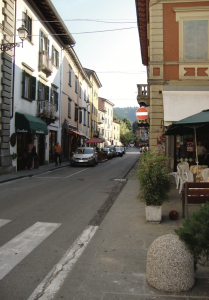
Not for me though. I was heading in the opposite direction to the Val di Lima in the lesser-travelled area of northern Tuscany known as the Garfagnana. Living and working in the Georgian elegance of Bath in the southwest of England, I was particularly interested to be making this journey to the small town of Bagni di Lucca tucked away in the northern hills of Tuscany. I had heard a little about its thermal springs and links with other spa towns in Europe and was keen to find out more about its history and the modern-day legacy.
North to Lucca
Heading north from Pisa airport we follow the signs to Lucca, a fascinating walled city with its own illustrious history. It is only about 20km from Bagni di Lucca and well worth a visit – even a flying one – as mine was. Colonised since pre-Roman times this small and perfectly formed city was completely immured in the 17th century, and now it is totally pedestrianised, and consequently tourist-friendly all year round. Cycling is big business and you can hire a bike for €2 and circumnavigate the ramparts. It offers you a 360-degree vantage point like no other and is a superb way to see the city. Within the walls, there is a concentration of historical buildings from many eras: you can’t miss the Guinigi Tower complete with its tree-fringed rooftop, Caffè di Simo where Puccini used to play, the magnificent Romanesque cathedral, and the Piazza dell’Anfiteatro whose oval 18th-century construction follows the lines of the original Roman amphitheatre.
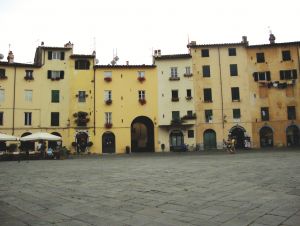
Off to the Hills
Beyond Lucca we are following the route of the Lima river which gives its name to this rural region. The landscape becomes more dramatic as darkly wooded hillsides rise steeply from the valley floor and while it’s true that these vertiginous slopes are part of the Tuscany-Romagnan Appenines, their height above sea level is a mere 152 metres. The spectacular river valley runs through several small villages until you come to Borgo a Mozzano and the arresting sight of the Ponte della Maddelena, better known as the Ponte del Diavolo, or Devil’s Bridge.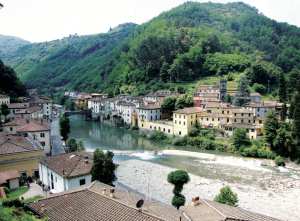
As with so many ancient monuments, there are various tales to be told: the historical reality is that a wealthy 12th-century benefactor, Matilde di Canossa had the bridge built to allow locals access from one side of the river to the other – so far, so practical. The folklore which surrounds its construction tells of sixth-century St Julian, the patron saint of travellers, who according to legend asked the Devil to help complete the ambitious construction. In return, St Julian promised him the soul of whoever made the first crossing of the bridge. The Devil agreed, assuming he would seize the soul of the holy man, but the canny saint arranged for a dog to make the first trip.
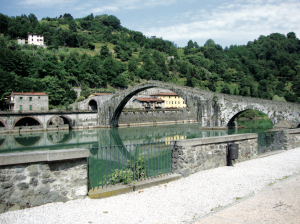
Folklore aside, the architecture of this stone bridge is quite breathtaking, with the seven magnificent medieval arches spanning the water. On a still day each one joins with its reflection to create shimmering circles on the water. A photo opportunity not to be missed and a grand gateway to take you on to Bagni di Lucca.
The Power of Three
Bagni di Lucca actually comprises three smaller townships, namely Fornoli, the newer and most populated area in which the railway station is situated, Ponte a Serraglio, the picturesque area which runs along the banks of the river Serchio and La Villa where you’ll find most of the shops and hotels, along with a scattering of 25 small hamlets and villages in the surrounding hills which make up the wider Bagni di Lucca comune. Dotted around the hills are thermal springs whose healing properties have been been known since Roman times.
In the 19th century, the spa became hugely popular with European aristocracy and benefitted from its wealth and patronage as the milords stopped off on their grand tours of Europe. It has strong connections with the English that date back to James the Third ‘the King who never was’. His royal patronage of the thermal springs spread through the other royal houses of Europe and its reputation spread as a fashionable watering place in aristocratic circles.

Evidence of Bagni’s illustrious past are found around every corner, and the beauty of this tiny town is that you can cover a lot of ground in just a couple of hours. If like me you are of a literary persuasion, you will delight in the knowledge that poets like Byron, Shelley and the Brownings stayed here to holiday and to be inspired, as well as other literary luminaries like Anthony Trollope and Michel de Montaigne, the French philosopher and essayist. He came here to take the waters and rented an elegant house in La Villa. Such was the attachment to Bagni di Lucca of one UK diplomat, Colonel Stisted, that he got permission to build a Protestant English Church in 1840 (no mean feat in this devoutly Catholic country).
At first glance, this neo-Gothic building looks more like a palazzo than a church, there’s no spire, no belltower, but this was a stipulation of Carlo Lodovico di Borbone, the Duke of Lucca, who didn’t want it to look like a ‘real’ church. Since 1976 it has belonged to the comune and is used as the Public Library and Historical Records Office with an impressive collection of 20,000 antiquarian English books. You can ask at the tourist information office to be shown around: there’s a real sense of history in the place and I found the juxtaposition of those amazing books and the magnificent 19th-century engraving of Anglican Creed at once incongruous and strangely uplifting. There’s more evidence of the Brits’ occupation in Jean Varraud square at the Circolo dei Forestieri (The Foreigners’ Club) and at the English cemetery built again by the Stitsteds in 1842, both of which are in easy walking distance.
Just round the corner and up the hill from the English Church, I pass the site of the Hotel Continentale (now the local primary school) –where the Queen of Italy, Margherita di Savoia once stayed – to the 16th-century Villa Ada, once the residence of the De’Nobili family, but now the location for the public swimming baths open during the summer months and supplied with naturally heated thermal water from the hills.
Taking the Waters
I feel culturally immersed and inspired after my literary tour around La Villa but I am ready to put my feet up. I am staying at the Antico Albergo Terme right up at the highest part of the town, in an ancient village of the comune called Bagni Caldi. Here is a real example of nature’s synergy as the peaceful setting makes the steep climb so worthwhile – the fresh scents and sounds of the forest all around you still your mind to prepare your body for the therapeutic treatments provided by the naturally occurring thermal springs.
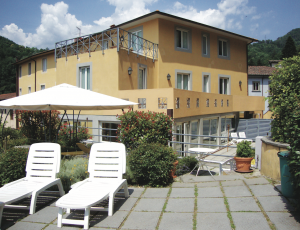
The thermal spa is part of the thermal complex of Jean Varraud and Casa Boccella, which offers traditional thermal cures and treatments. Here the hottest springs in the area are used for a huge range of therapeutic and medicinal treatments. It’s a clinical environment where the natural properties of the waters and muds are used to treat internal and external conditions in adults and children, from acne and rheumatism to blood disorders and gynaecological problems. Many of the guests at the hotel which is situated next door are here to take the ‘cure’, while others like myself are tempted by the oasis of calm the hotel ambiance offers and the beauty treatments to choose from at the Wellbeing Centre Ouida.
So that is how I find myself emerging from a steam session in the Grotta Grande, the largest of the two thermal caves, sweating from head to toe, only to be swathed in cotton sheets and a final layer of… thick blanket. It must have been one of the hottest days of the year as the sun filtering through the windows told me, but the blankets were essential, not an option, I was firmly told.
This 20-minute enforced lie-down will produce what the therapist called the ‘reazione’ – a total relaxation of mind and body and while I was slightly distracted at first by the sensation of so much perspiration (well, I am a lady and normally just ‘glow’), I slipped into a deeply relaxed, if not comatose state by the time my 20 minutes were up. My limbs were then gently brought back to life by an anti-stress massage with deliciously scented aromatic oils. I slept well that night. The combination of a good walk, gallons of fresh air, the therapeutic administering of the thermal waters and deliciously prepared tagliata di manzo for supper were the perfect prescription for a restful eight hours.
An oasis of calm
As I prepare to leave, I feel wistful. I have crammed a lot into my short stay in Bagni di Lucca: I didn’t have time to visit the the outlying villages, but that is definitely one reason to return to this spectacular corner of northern Tuscany, as its rich historical heritage. I have certainly fallen under the same spell as the literary giants of years gone by, who recognised in this remarkable little pocket of civilisation, a beauty and peace that must have been as elusive to capture in the centuries past as it is today. I will take the healing power and natural splendour of these thermal hills with me: ready to face the rigours of extreme sightseeing as I head further south towards the glories of Florence and Siena.
